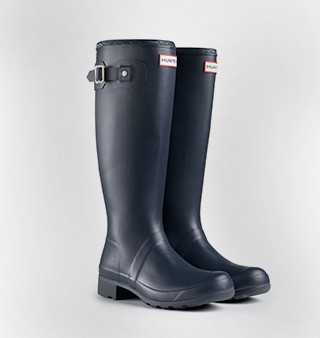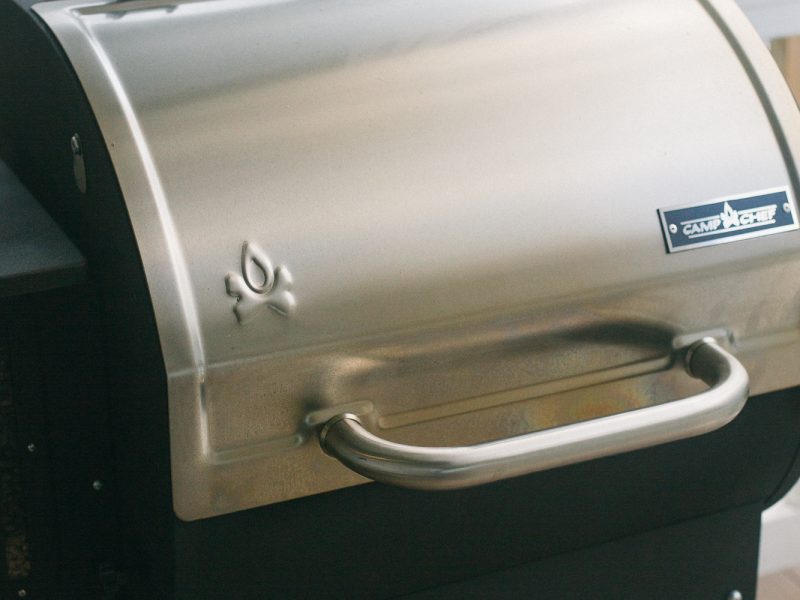Yesterday marked the first day in Chicago of cold autumn rain. And certainly not the last. Being an avid walker in all types of weather, that means I have to have footwear that can handle

wet weather — any kind of wet weather from hot rain to snow. Of course you can get rainboots anywhere, but traditional rainboots have some serious issues.
Why Traditional Rainboots Are Bad (For most uses)
Rainboots like the Hunter Wellingtons shown above are perfect for riding horses. Their solid construction and heel makes them perfect for working with large livestock and putting your feet in stirrups.
But I don’t ride horses very often. When I’m walking in the rain in Chicago this kind of construction makes them excessively heavy and their stiff construction and heel impairs a natural walking form. When I walk over 4 miles every single day, I don’t want to carry this kind of weight. I also don’t think it’s very good for your feet to walk long distances with a heel. Allowing your feet to move naturally gives them a full workout, resulting in stronger healthier feet (arch support? your fully exercised feet will support themselves). You can’t get that kind of a workout in a shoe that impairs your movement.
Are you riding a horse? Mucking out a barn full of cows? If not, you don’t need these kind of features.
Luckily there are a few alternatives out there for those of us who want something more minimalist.
2017 Update: Things I Learned Since I First Published This Post
When I first published this post in 2014 I had a lot to learn. Back then most of the footwear I selected was made with synthetics and imported. I now chose to buy shoes made by craftspeople, ideally locally or in the United States, not just because I want to support sustainable local economics, but because I want a product made to last a lifetime and that’s repairable by myself or a cobbler. I also have moved away from synthetic products because I learned more about the advantages of natural materials like leather and animal skins, such as odor resistance, flexibility, and longevity. The disadvantage is these shoes are significantly more expensive and require specialized care.
My Criteria

Flexibility – standing on the foot’s ball in the Bog’s Summit
What I look for in shoes is:
- Flexibility: I don’t want my feet stuck on a stiff plane- I want them to be able to flex. The test for this is weather or not you can flex to stand on just the ball of your foot.
- Durability: Most of these shoes are not cheap. If I’m going to pay that much, I want them to last. And last through a life of walking miles every single day. Ideally I’d also like them to be repairable/resolable by a cobbler.
- Zero-drop: Heels impair my natural stride. I don’t want them. I want a completely flat sole.
- Weatherization: Handling a wide range of temperatures comfortably, ability to handle all kinds of weather from sleet to drizzle and everything in between
- Foot Freedom: Does the shoe cramp the foot into a tiny narrow toe box? Or does it allow the foot to move freely?
- Casual: You won’t see many Five Fingers on this list. I don’t want anything that looks like I’m going to the gym. I just want normal-ish shoes.
- Little/No Arch Support: Strong feet will support themselves
- Domestically made: I’d like to support local manufacturing and craftsmanship, as well as avoid footwear made in countries with lower standards for labor-rights and environmental protection. I’d prefer USA/Canada-made, but if that’s not available, European-made or those sourced carefully and responsibly from other countries.
Katy Says also has some great info about criteria to look for in shoes.
Flexible Lightweight Rubber Boots
Rubber is probably the definitive waterproof material. When I went to Scotland I bought some Vivo Barefoot rubber Wellingtons that performed really well in wet environments without being very heavy. In fact they were great for traveling too because they could be folded up nicely for packing. Unfortunately they broke pretty quickly and I haven’t found a great replacement. I wear my Bean Boots a lot in the rain, they are American-made and repairable, but very heavy, inflexible, and heeled. I own the flat lightweight Sorel Out and About’s, but they are not as well constructed and made in China. So if you have some suggestions in this area, I’d love to hear them. Gumleaf seems promising.
Water-Resistant Boots
These boots are not completely waterproof, but possess different levels of water resistance. In return for not being entirely waterproof, they are much more breathable, so they can be worn comfortable even when it’s not raining/sleeting.
Some of them claim to be 100{cdc8dacb124d4b27fd7a4c8cb0e89e6e093c68cad0607afd388ff915747d78c2} waterproof, but that’s a lie– if you stand in a giant puddle with them for long enough you will eventually get wet. But they can handle most rain and many can also handle snow/sleet. A disadvantage is in very heavy rain the outer parts of these boots will get wet and take some time to dry later, but if the boot is well-made, the water won’t penetrate to where your feet are. The other problem is they can get stained, so they are not a good choice for mud or other dirty sticky terrains. Rubber boots can be hosed off, these often can’t.
I owned Vivo Barefoot short boots, which lasted a long time (6 years), before breaking. I also liked Bogs Summit initially, but they are plagued with the odor issues of the synthetic Vibram Five Fingers.

Russell Minimalist Country Squire Signature South 40 Birdshooter
Durability: Unknown but they seem VERY sturdy and can be resoled
Temperature range: I got them with 200g thinsulate so I think they can handle down to at least 0 F
Waterproofing: Excellent so far, can handle rain and snow
Flexibility: Medium
Foot Freedom: High
Cost: $530.00
Similar, but for men: These are custom made so they are unisex!
Made in: USA
I think these are the most expensive shoes I’ve ever bought? They took a long time to make too (my order took 7 months), but they are made for my exact measurements and they are “buy it for life” quality which means I’ll have these for a very long time and be able to repair them. They are zero-drop and made with the Munson Army Last, which is supposed to provide your foot with barefoot-like freedom. You can see more pics on a post I made on Reddit 🙂
Snow Boots
Very cold weather is a great example of when shoes that allow natural movement give you a huge advantage. When I used to wear stiff Bean Boots as snow boots, the fact they don’t allow your feet to really move turned my feet into blocks of ice. The ideal very cold weather boot should perform like a traditional Arctic mukluk and allow your feet to truly move, generating heat and preventing them from getting really cold.
I owned Cushe Cabin Fever Boots for 6 years before they gave out. They were not repairable, so I made a pretty significant upgrade to the Steger Mukluks

Steger Canyon Mukluks
Durability: Holding up well after 3 years, though you can see some wear
Temperature range: down to -10 F
Waterproofing: Can handle some wet snow OK, but mostly for dry snow
Flexibility: Medium
Foot Freedom: High
Cost: 269.95.
Potential alternatives: Manitobah Mukluks- made in Canada (may not handle sleet as well, also some styles are now “imported”), Soft Star Phoenix
Similar, but for men: some of Manitobah’s more minimal designs
Made in: USA
A massive upgrade from my previous boots, these are incredible lightweight, warm, and flexible. They have a unique style that’s not appropriate for everywhere, but I usually change out of them when I get to work anyway. Due to the materials and price, I’m careful not to get them wet, but that’s hard because Chicago has a lot of wet snow. So far I haven’t had any major issues though they’ve gotten a bit wet a few times.
Warmer Weather Options
Temperatures above 80 F make it extremely hard to find footwear that can handle rain. Even the lightest weight textile boots above are uncomfortable at these temperatures. The main option is to accept your feet probably will get wet, which is kind of OK since it’s not cold, though gross, and at least have the shoes themselves not ruined, easy to clean, and dry quickly.

Tread Light Maori Sandal
Durability: High (1+ years)
Temperature range: 75+
Waterproofing: 70{cdc8dacb124d4b27fd7a4c8cb0e89e6e093c68cad0607afd388ff915747d78c2}
Flexibility: High
Foot Freedom: High
Cost: ~$85
Similar, but for men: Men’s model Made in: USA
Handmade in the US, these look pretty good and handle water well, though I mainly wear the sandals I made at a class rather than these now.

Soft Star Adult Sport Ballerine Flat
Durability: At two and a half years of heavy wear, they now have a small hole in them, but they are still wearable.
Temperature range: 40+ if worn with heavy tights
Waterproofing: None, but reasonably water resistant
Flexibility: High
Foot Freedom: High
Cost: ~$130
Made in: USA
These are merely water resistant, but seem to handle intermittent rain pretty well. Made exactly for flexibility and lightweight comfort, I just can’t believe it took me so long to order a pair. I just kind of wish I’d chosen a prettier color combo haha.
Let us know your own recommendations and tips in the comments. And follow my Pinterest Board for shoes that interest me that I may not have tested yet.
SOURCE: Hunt Gather Love – Read entire story here.

